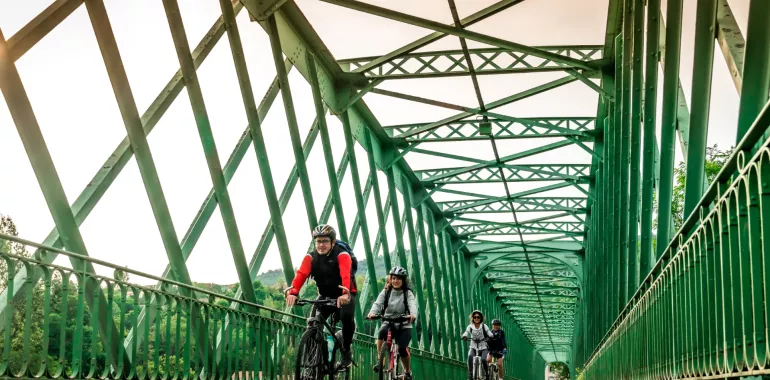26,86 km cycling route from Pont-du-Château to Vic-le-Comte
Elevation of the stage
Waytypes of the stage
Surface of the stage
The Via Allier cycle route from Pont-du-Château to Vic-le-Comte
Leave Pont-du-Château via Avenue de Cournon and the D783 road. At the roundabout, go straight over to cross the Allier River via an iron bridge to reach Dallet. While awaiting the continuation of the cycle route right beside the river, you have to distance yourself from the Allier to reach Vic-le-Comte. The Via Allier crosses Mur-sur-Allier, Saint-Bonnet-lès-Allier and Ceyssat. Here, appreciate the volcanic nature of the region’s mountains as you tackle the first real climbs on the Via Allier cycle route. As a reward, enjoy the views from the Puy de Mur, then those from below the hilltop on which the Château de Busséol stands, at 572m in altitude.
Links to the surrounding villages of character
You need to leave the Via Allier cycle route to reach Chauriat, Bansat and Busséol
Link to the boucle cyclosportive " Le Circuit de la Comté, villages et châteaux perchés ". Leave Saint-Georges-ès-Allier via the D118 road towards Saint-Julien-de-Coppel.
Don't miss
- Vertaizon: the Gothic église Notre-Dame, an historic church built on a volcanic hilltop and that once sat alongside a feudal château, the latter demolished by order of Cardinal Richelieu.
- Clermont-Ferrand: the capital of the Auvergne Region, a city that’s dynamic and full of students and festivals. The two historic centres, Clermont and Montferrand, are linked by a traway now. Among highlights to visit are Clermont’s Gothic cathedral and Romanesque basilica, Montferrand’s medieval quarter, L’Aventure Michelin (about the town’s famed tyre factory) and the thermal spa resort of Royat-Chamalières on the heights above the centre.
- AOC Côte d’Auvergne wines made at Dallet, Mezel, Vertaizon, Chauriat, La Roche-Noire, Mirefleurs, Laps, Saint-Maurice-ès-Allier and Vic-le-Comte. The appellation d’origine protégée (AOC) Côtes d’Auvergne includes, as well as generic wine, five more local, specific denominations, granted to Madargue, Châteaugay, Chanturgue, Corent and Boudes. Gamay, pinot noir and chardonnay are the main grape varieties employed. For more information: Fédération Viticole du Puy-de-Dôme.
- Chauriat: a typical fortified village, one of over 140 developed around the Grande Limagne area from the end of the Middle Ages. These fortified ensembles were created in reaction to the insecurity that reigned in these parts from the late 13th century on and that only increased through the Hundred Years War. As local lords were no longer called on to ensure the villages’ defences, inhabitants organized these themselves to improve their own safety. The Église Saint-Julien is an historic Cluniac edifice.
- La Roche-Noire / Pérignat-sur-Allier: the Écopole du Val d'Allier extends across 140 hectares, set within a meander in the Allier known as La Gondole. In times past, the spot was exploited for gravel quarrying, but it has been gradually transformed into a protected natural area. This area is fringed by a forest growing on a flood plain and mainly consisting of willows, oaks and poplars.
- Busséol: the fortress was the main headquarters of the Counts of Auvergne for some time and became the oldest royal estate in the province. Today, it is once again lived in and furnished. One fireplace dates back to the 12th century. In the courtyard, there’s an exceptional garden to enjoy, along with beautiful views.
- Vic-le-Comte: this town has been awarded Petite Cité de Caractère status and inside the église Saint-Pierre, the splendid choir end, built in the 16th century, was designated a Sainte-Chapelle for the holy relics supposedly linked to Christ that it once contained. Some of the interior decorations may have been ordered by French Renaissance queen, Catherine de’ Medici, while on the exterior, spot mythical carved beasts.
- Markets: Pont-du-Château – Thursday and Saturday morning; Mur-sur-Allier (Mezel) – Thursday morning; Vertaizon – Friday morning; Chauriat – Wednesday morning; Pérignat-ès-Allier – Saturday morning; Vic-le-Comte – Thursday morning
Railway station
Vic-le-Comte (Longues) : Line TER Clermont-Ferrand <> Vic-le-Comte (Longues)


Travellers’ reviews